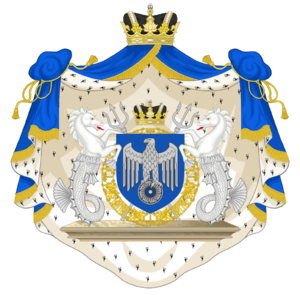User:Geordinia/sandbox7
Jump to navigation
Jump to search
| Constitution of the Kingdom of Rajyaghar | |
|---|---|
 | |
| Original title | Supreme Constitution of the Federated Kingdom of Rajyaghar |
| Jurisdiction | Kingdom of Rajyaghar |
| Subordinate to | The Crown |
| Date effective | 17 October 1946 |
| System | Federal, Parliamentary, Monarchy |
| Branches | 3 |
| Chambers | Bicameral |
| Executive | Premier |
| Judiciary | Supreme, State High, Crown |
| Federalism | Federation |
| Electoral college | No |
| Entrenchments | 2 (Articles I and X) |
| Location | Royal Library, Kinadica |
| Commissioned by | Consular Senate |
| Author(s) | Consular Senate |
| Signatories | Krishan VI |
| Supersedes | Etrurian Colonial Law |
| Article | Title | Description | Amendments | Entrenchments |
|---|---|---|---|---|
| I | The Crown | Establishes Rajyaghar as a Constitutional Monarchy, affirms the power of the Constitution as teh Supreme Law to be derived from the authority of the Monarch and outlines the duties, role, protections and constitutional privileges granted to the Monarch and the Royal Family. Includes clauses pertaining to succession, regency and abdication. | 0 | 1 - Prohibits the abolition of the Monarchy and dictates that no amendments may be considered without the explicit consent of the Monarch acting at their own discretion |
| II | Federal Governance | Establishes Rajyaghar as a federal, constitutional democracy in which the country is divided into Union States and Federal Territories. Divides the Federal Government into 3 branches; legislative, executive and judicial. | 0 | |
| III | Shahee Sansad | Establishes the Shahee Sansad as the bicameral legislative branch of the federal government. Codifies the upper house as the Council of States, comprising of appointed members, and the lower house as the House of Representatives, comprising of elected members. Delegates legislative power to the Shahee Sansad, including limitations. | ||
| IV | Central Union Government | Establishes the Central Union Government as the executive branch of the federal government. Codifies the position of Premier of Rajyaghar as the Head of Government, the Ashta Pradhan as the Cabinet of Ministers and delegates basic authorities to these positions. | 0 | |
| V | Supreme Court | Establishes the Supreme Court as the judicial branch of the federal government, placing it above all other judicial systems that may be created by the Constitution. Dictates that the Supreme Court is to be the final court of appeal under the Crown and that decisions made by the Supreme Court bind all other courts within the Kingdom. Creates the Independent Judicial Appointments Commission to advise the Monarch on appointments to the Supreme Court. | 0 | |
| VI | Federalism | Establishes the Union States and Federal Territories of the Kingdom of Rajyaghar. Outlines the duties of the state governments and their relationship with the federal government. Prohibits secession of Union States and Federal Territories aand contains clauses relating to the suspension of state governments. | 0 | |
| VII | Citizenship | Establishes what is meant by having Rajyani Citizenship, the requirements and the offences that may deem it revocable. | 0 | |
| VIII | Article of Rights | Establishes a basic set of rights afforded to all citizens of the Kingdom of Rajyaghar and circumstances in which these rights may be temporarily suspended or revoked. | 0 | |
| IX | States of Emergency | Establishes States of Emergencies, the requirements for their declaration, the powers delegated and the process of withdrawing from a State of Emergency. | 0 | |
| X | Amendments and Repeal | Establishes the process of amending the Constitution as well as repealing it. Outlines that all amendments may first be put forward to the House of Representatives, passed by a 2/3rds majority before moving to the Council of States where it must pass by a 2/3rds majority. Amendments must then be put to a public referendum and must pass by a simple majority with a turnout of at least 50%. Amendments must then be signed or vetoed by the Monarch. Vetos may not be overturned but the amendment may be reintroduced in 12 months time. Amendments may avoid a public referendum in times of emergency. Repealing the Constitution requires an additional stage prior to the public referendum in which all Union State legislatures must approve the repeal by a simple majority. A repeal of the Constitution cannot avoid a public referendum. | 0 | 1 - This article cannot be amended or repealed. |